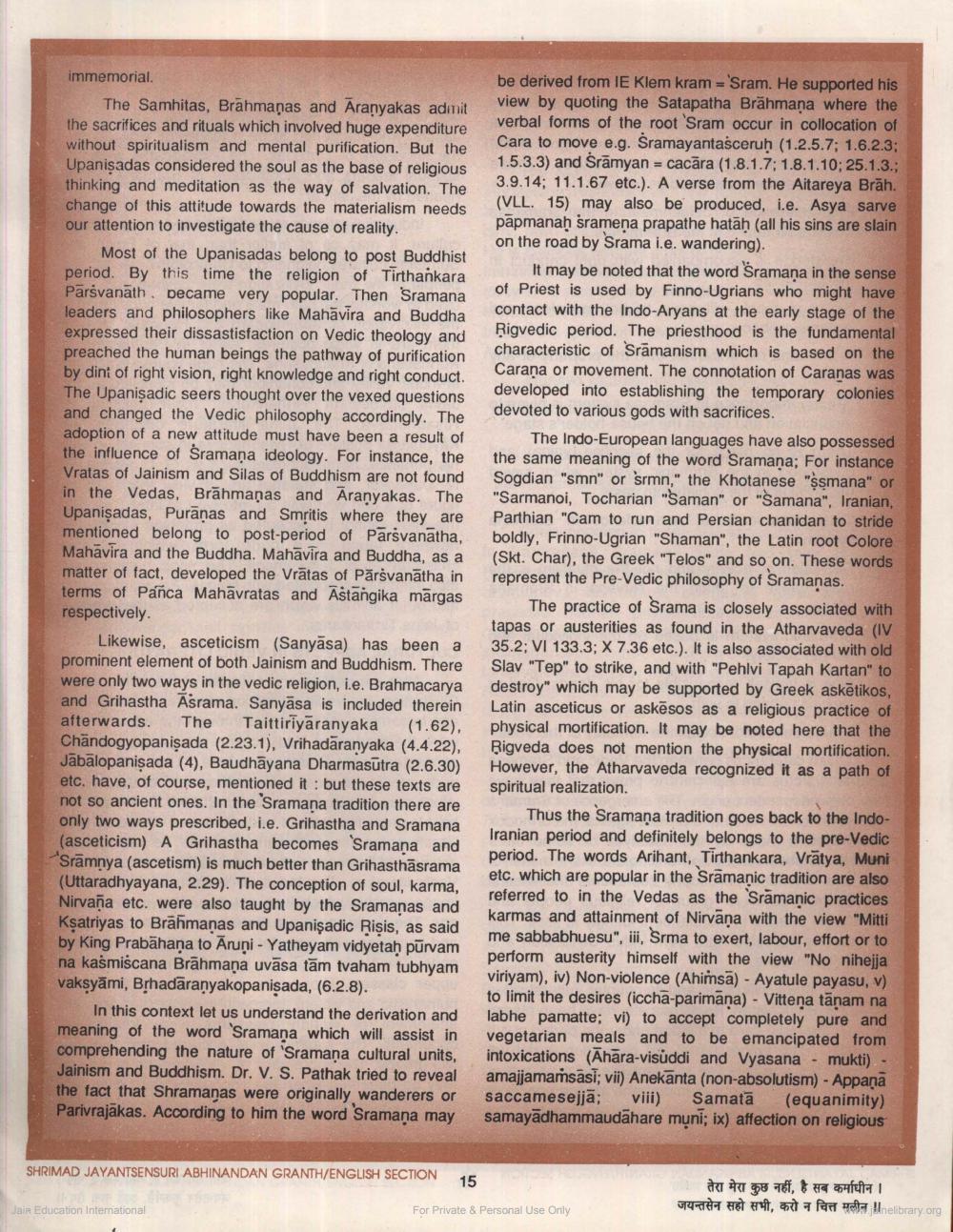________________
immemorial
The Samhitas, Brahmanas and Aranyakas admit the sacrifices and rituals which involved huge expenditure without spiritualism and mental purification. But the Upanisadas considered the soul as the base of religious thinking and meditation as the way of salvation. The change of this attitude towards the materialism needs our attention to investigate the cause of reality.
Most of the Upanisadas belong to post Buddhist period. By this time the religion of Tirthankara Pārsvanath, became very popular. Then Sramana leaders and philosophers like Mahavira and Buddha expressed their dissastisfaction on Vedic theology and preached the human beings the pathway of purification by dint of right vision, right knowledge and right conduct. The Upanişadic seers thought over the vexed questions and changed the Vedic philosophy accordingly. The adoption of a new attitude must have been a result of the influence of Sramaņa ideology. For instance, the Vratas of Jainism and Silas of Buddhism are not found in the Vedas, Brāhmaṇas and Aranyakas. The Upanişadas, Puranas and Smritis where they are mentioned belong to post-period of Parsvanatha, Mahavira and the Buddha. Mahavira and Buddha, as a matter of fact, developed the Vrātas of Pārsvanātha in terms of Panca Mahāvratas and Astangika mārgas respectively.
Likewise, asceticism (Sanyāsa) has been a prominent element of both Jainism and Buddhism. There were only two ways in the vedic religion, i.e. Brahmacarya and Grihastha Asrama. Sanyāsa is included therein afterwards. The Taittiriyāranyaka (1.62), Chandogyopanişada (2.23.1), Vrihadāranyaka (4.4.22) Jābālopanisada (4), Baudhāyana Dharmasūtra (2.6.30) etc. have, of course, mentioned it : but these texts are not so ancient ones. In the Sramana tradition there are only two ways prescribed, i.e. Grihastha and Sramana (asceticism) A Grihastha becomes Sramana and "Sramnya (ascetism) is much better than Grihasthäsrama (Uttaradhyayana, 2.29). The conception of soul, karma, Nirvana etc. were also taught by the Sramanas and Ksatriyas to Brāhmanas and Upanişadic Risis, as said by King Prabāhana to Aruni - Yatheyam vidyetah pūrvam na kašmiscana Brāhmana uvāsa tām tvaham tubhyam vaksyāmi, Brhadāraṇyakopanişada, (6.2.8).
In this context let us understand the derivation and meaning of the word 'Sramana which will assist in comprehending the nature of 'Sramana cultural units, Jainism and Buddhism. Dr. V. S. Pathak tried to reveal the fact that Shramanas were originally wanderers or Parivrajakas. According to him the word Sramana may
be derived from IE Klem kram = 'Sram. He supported his view by quoting the Satapatha Brahmana where the verbal forms of the root 'Sram occur in collocation of Cara to move e.g. Sramayantasceruh (1.2.5.7; 1.6.2.3: 1.5.3.3) and Srāmyan = cacāra (1.8.1.7; 1.8.1.10; 25.1.3., 3.9.14; 11.1.67 etc.). A verse from the Aitareya Brāh. (VLL. 15) may also be produced, i.e. Asya sarve pāpmanah sramena prapathe hatā (all his sins are slain on the road by Srama i.e. wandering).
It may be noted that the word Sramana in the sense of Priest is used by Finno-Ugrians who might have contact with the Indo-Aryans at the early stage of the Rigvedic period. The priesthood is the fundamental characteristic of Srāmanism which is based on the Carana or movement. The connotation of Caranas was developed into establishing the temporary colonies devoted to various gods with sacrifices.
The Indo-European languages have also possessed the same meaning of the word Sramana; For instance Sogdian "smn" or srmn," the Khotanese "ssmana" or "Sarmanoi, Tocharian "Saman" or "Samana", Iranian, Parthian "Cam to run and Persian chanidan to stride boldly. Frinno-Ugrian "Shaman", the Latin root Colore (Skt. Char), the Greek "Telos" and so on. These words represent the Pre-Vedic philosophy of Sramanas.
The practice of Srama is closely associated with tapas or austerities as found in the Atharvaveda (IV 35.2; VI 133.3; X 7.36 etc.). It is also associated with old Slav "Tep" to strike, and with "Pehlvi Tapah Kartan" to destroy" which may be supported by Greek askētikos, Latin asceticus or askēsos as a religious practice of physical mortification. It may be noted here that the Rigveda does not mention the physical mortification. However, the Atharvaveda recognized it as a path of spiritual realization.
Thus the Sramaņa tradition goes back to the IndoIranian period and definitely belongs to the pre-Vedic period. The words Arihant, Tirthankara, Vrātya, Muni etc. which are popular in the Srāmanic tradition are also referred to in the Vedas as the Sramanic practices karmas and attainment of Nirvana with the view "Mitti me sabbabhuesu", iii, Srma to exert, labour, effort or to perform austerity himself with the view "No niheija viriyam), iv) Non-violence (Ahimsā) - Ayatule payasu, v) to limit the desires (iccha-parimana) - Vittena tānam na labhe pamatte; vi) to accept completely pure and vegetarian meals and to be emancipated from intoxications (Ahāra-visúddi and Vyasana - mukti) amajjamaṁsāsi; vii) Anekānta (non-absolutism) - Appaņa saccamesejjā; viii) Samatā (equanimity) samayādhammaudāhare muni; ix) affection on religious
SHRIMAD JAYANTSENSURI ABHINANDAN GRANTH/ENGLISH SECTION
15
तेरा मेरा कुछ नहीं, है सब कर्माधीन । para ele, a fer udalelibrary.org
Jain Education International
For Private & Personal Use Only




